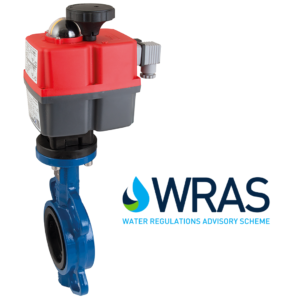Electric Actuated WRAS Ball & Butterfly Valves
Are you in need of reliable and efficient valves for your water supply system? Traditional manual valves can be difficult and time-consuming to operate, especially in hard-to-reach areas. Fortunately, there is a solution that can make your life much easier: electric-actuated WRAS ball and butterfly valves.
Electrically Actuated WRAS Approved PN16 Butterfly Valve
An electrically actuated WRAS approved butterfly valve is a valve that controls the flow of fluid through a pipe. It is specifically designed to be used in drinking water applications, and is approved by the Water Regulations Advisory Scheme (WRAS) in the UK.
The valve consists of a disc that is mounted on a shaft. When the valve is in the open position, the disc is parallel to the direction of flow, allowing fluid to pass through with minimal resistance. When the valve is closed, the disc is perpendicular to the direction of flow, blocking the passage of fluid.
The valve is operated by an electric actuator, which is connected to the shaft. When the actuator receives a signal, it rotates the shaft and moves the disc to the desired position. The actuator can be controlled manually or remotely, depending on the application.
Key Features of Actuated Butterfly Valves
One of the key features of this valve is that it is powered by electricity, which means that it can be operated remotely.
This makes it ideal for use in situations where the valve is located in a hard-to-reach area, or where it is necessary to operate the valve quickly and efficiently.
Another key feature of this valve is that it is WRAS approved, which means that it has been tested and certified to meet the high standards set by the Water Regulations Advisory Scheme.
This certification ensures that the valve is safe to use in contact with drinking water, and that it meets the requirements for quality and reliability.

Electrically Actuated WRAS Approved Ball Valve
An Electric Actuated WRAS Approved Ball Valve is a type of valve used for controlling the flow of liquids. It is designed to meet the Water Regulations Advisory Scheme (WRAS) approval, ensuring it is safe to use in water supply systems.
The valve operates by using an electric actuator to control the position of a ball inside the valve body. The ball has a hole in the centre that allows fluid to pass through when the valve is in the open position.
When the electric actuator receives a signal, it rotates the ball inside the valve body to either open or close the valve. This allows for precise control over the flow of liquid and allows the valve to be operated remotely.
Key Features of Actuated Ball Valves
One of the most important features of this valve is its electric actuation. This allows the valve to be controlled remotely, making it ideal for use in hard-to-reach locations. It also ensures precise control of the flow rate, which is crucial for maintaining water pressure and preventing leaks.
Another key feature of this valve is its WRAS approval. WRAS stands for Water Regulations Advisory Scheme, and it is an independent body that provides approval for products that meet strict standards for safety and quality. A WRAS-approved valve is guaranteed to be safe and reliable, making it the ideal choice for use in water supply systems.
The materials used in the construction of the valve are also important. A WRAS-approved ball valve is typically made from high-quality materials such as brass nickel-plated or stainless steel, which are resistant to corrosion and other types of damage.
Why Use an Electric Actuator Instead of a Pneumatic Actuator?
Electric actuators offer numerous advantages over their pneumatic counterparts. They offer precise control and positioning, which is critical in many industrial settings. With an electric actuator, you can achieve highly accurate and repeatable movements, which is essential for applications that require precise positioning or load control.
Electric actuators are also more energy-efficient than pneumatic actuators. They consume less power because they do not require a compressed air supply, which can be a significant source of energy waste. In addition, electric actuators generate less heat and noise than pneumatic actuators, making them ideal for applications where noise and heat are concerns.
Another benefit of electric actuators is their greater flexibility. They can be easily integrated with other systems and devices, such as sensors and programmable logic controllers. This allows for greater automation and control, which can improve efficiency and reduce labour costs.
Finally, electric actuators are more reliable and require less maintenance than pneumatic actuators. Because they have fewer moving parts, they are less prone to wear and tear, which means they require fewer repairs and replacements. This can save companies significant amounts of money in maintenance and downtime costs.
Conclusion
In conclusion, electric actuated WRAS ball and butterfly valves offer many benefits for industries that require reliable and efficient fluid control systems. These valves are designed to comply with strict regulations and standards, ensuring safe and clean water supply.
With their advanced technology and automation capabilities, electric actuated valves can improve productivity, reduce costs, and enhance overall performance. If you’re looking for a high-quality valve solution, consider electric actuated WRAS ball and butterfly valves for your next project.
